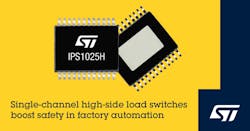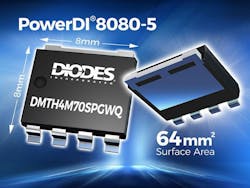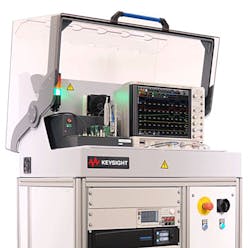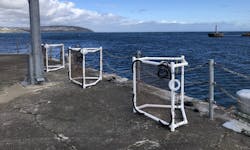This Week in PowerBites: USB PD Simplified, Protective "Electric Reefs"
This article is part of the This Week in PowerBites Library Series.
IEEE International Electron Devices Meeting Announces 2022 Call for Papers
The IEEE International Electron Devices Meeting (IEDM) has issued a call for papers for their 2022 conference, to be held December 3-7, 2022 in San Francisco. Now celebrating its 68th year, IEDM continues to be a forum for much of the world’s best original work in all areas of semiconductor and related device technology, manufacturing, design, physics, and modeling.
Although the conference's focus has expanded to include topics as diverse as DNA-based data storage and quantum information technologies, an abundance of programming related to power devices, device reliability, and similar technologies will be in the mix, too.
The 2022 event is being planned as an in-person conference at the Hilton San Francisco Union Square hotel, with on-demand access to recorded presentations available after the event for those unable to travel due to COVID-19 restrictions.
The paper submission deadline is Friday, July 14, 2022. Authors are asked to submit four-page camera-ready papers. Accepted papers will be published as-is in the proceedings. A few late-breaking-news submissions will also will be accepted, covering only the most recent and noteworthy developments. The late-news submission deadline is August 22, 2022.
For more information about IEDM 2022, visit their home page at www.ieee-iedm.org. And for further details on submitting your paper, visit the author information page.
Dual-Channel DC-DC LED Headlamp Controller Supports Smart Features Without an MCU
The latest member of Infineon Technologies’ LITIX Power family is the TLD6098-2ES, a dual-channel, standalone dc-dc controller. According to the company, it’s the first product that can drive a full LED headlamp by itself without an additional microcontroller, and that it will help simplify design and reduce cost of implementing high-safety and high-style LED front lighting.
It also can operate the four standard LED front-light functions: High Beam (HB), Low Beam (LB), Daytime Running Lights (DRL), and Turn Signal (TURN). Moreover, it’s possible to use LITIX Power products as a voltage supply to meet the growing demand for animation in exterior LED lighting.
As a multi-topology controller, the TLD6098-2ES enables boost, buck, SEPIC, and flyback mode operation. The integrated PMOS gate drivers provide high-side load disconnection to dim the LED brightness and ensure adequate system reliability. In addition, an integrated spread-spectrum modulator improves the EMC performance to facilitate system qualification at the customer site.
Each channel of TLD6098-2ES offers both analog and PWM dimming for precise LED brightness control. With the wide 4.5- to 60-V input-voltage range, even 24-V battery-system applications can be supported.
Pricing & Availability
LITIX Power family products can be ordered now, with samples priced at about $3 (and volume quantities half that). Got to TLD6098-2ES - Infineon Technologies for further data on the device, links to pricing, and datasheet information.
Single-Channel Load Switches for Apps with High Startup Currents
STMicroelectronics has released single-channel versions of its programmable high-side switches, the IPS1025H and the IPS1025H-32. Both devices feature built-in protection for undervoltage, overvoltage, overload, and overtemperature to simplify the intelligent driving of capacitive, resistive, or inductive loads, which draw high startup current.
The IPS1025H and IPS1025H-32 are virtually identical except for their internally programmed current limits—2.5 A for the IPS1025H and 5.7 A for the IPS1025H-32. In addition to the main current limit, each switch has a secondary, user-programmable limit that can be used to manage capacitive loads with high initial startup currents. The limit value and duration are set using external resistors and a capacitor.
Featuring a very wide supply and input-pin voltage range from 8 to 60 V plus the ability to withstand up to 65 V on the input pin, the compact devices ensure reliable performance in industrial applications. Typical uses for the IPS1025H include driving loads controlled by PLC modules and for use in factory-automation equipment such as I/O peripherals and CNC machines. The IPS1025H-32, with its higher maximum current limit, is well-suited for use with unidirectional motors in equipment like vending machines.
The switches' integrated MOSFET switch has a low RDS(on) (≤25 mΩ up to TJ = 125°C), resulting in high energy efficiency and low thermal dissipation. With a single-pulse avalanche energy greater than 1 J at 2 A, the MOSFET boosts reliability for handling inductive loads. An integrated active clamp provides fast demagnetization.
ST’s new programmable switches feature extensive built-in protection and diagnostics, enhancing safety and reliability by handling fault conditions that include undervoltage, overvoltage, overload, short circuit, ground, or supply-rail disconnection. An additional sensor is provided for case overtemperature protection. The switches meet IEC 61000-4-2 ESD, IEC 61000-4-4, and IEC 61000-4-5 specifications for ESD, fast-transient, and surge immunity.
Demonstration boards and software, including the X-NUCLEO-OUT05A1 and X-NUCLEO-OUT06A1 digital output expansion boards, are available for quick evaluation. There’s also software for use with the STM32 Nucleo development boards plus software drivers associated with the X-CUBE-OUT5 software. Source code for a graphical user interface (STSW-IFAPGUI) is available as well.
The IPS1025H and IPS1025H-32 are in production now and available in the PowerSSO-24; cost is $3.51 for orders of 1,000 pieces. For more information, go to www.st.com/ips.
GaN Switches for USB PD 3.1 Adapters Deliver Up to 220 W at 95% Efficiency
Power Integrations has added several new devices to its InnoSwitch4-CZ family of high-frequency, zero-voltage-switching (ZVS) flyback controllers. When paired with the company’s ClampZero active-clamp IC the new ICs easily address the latest USB PD 3.1 specification for adapters and chargers up to 220 W. And, when compliance with global eco-standards is required, they can be used in conjunction with PI's recently announced HiperPFS-5 GaN-based power-factor corrector.
“The expanded power range of the new InnoSwitch4-CZ and ClampZero ICs allows charger/adapter designers to easily exceed 23 W per cubic inch for single- and multiple-output USB PD 3.1 certified designs,” explained Edward Ong, senior product marketing manager at Power Integrations.
“Even at 220 W of output power, the family’s high efficiency minimizes waste heat; bulky heatsinks are not required on any of the active devices,” said Ong. “The maximum switching frequency of up to 140 kHz minimizes transformer size, and the high level of integration approximately halves the number of passive components, MOSFETs, and diodes that make safety-compliant PCB layout a challenge.”
All InnoSwitch4-CZ ICs include a robust 750-V PowiGaN primary switch, active-clamp drive, and synchronous rectification in a compact InSOP-24D package. The devices also enjoy extremely accurate CV/CC thanks to PI's FluxLink high-speed secondary-side sensing technology.
On top of that, they feature a non-complementary-mode active clamp, enabling designs that work in both continuous (CCM) and discontinuous (DCM) modes. Operating across modes makes it easier for a design to support the wide load/range conditions often encountered in USB PD applications.
Availability & Resources
A super-compact, 130-W USB PD adapter reference design (DER-957) is available for designers wishing to evaluate the InnoSwitch4-CZ flyback controller IC and ClampZero active clamp IC chipset. Devices are priced starting at $3.07 for the INN4072C-TL and $0.66 for the CPZ1061M-TLXXX in 1,000-unit quantities. For further information, visit power.com or contact one of the company’s authorized worldwide distributors: Digi-Key, Farnell, Mouser, and RS Components.
Innovative Package Boosts Power Density for Modern Automotive Applications
The PowerDI8080-5 from Diodes Inc. is a high-current, thermally efficient power package designed to meet the needs of electric-vehicle (EV) applications. The first product to be housed in this package is the DMTH4M70SPGWQ, a 40-V automotive-compliant MOSFET that features a typical RDS(on) of just 0.54 mΩ at a gate drive of 10 V, while its gate charge is 117 nC. These performance levels help maximize the system efficiency of automotive high-power BLDC motor drives, dc-dc converters, and charging systems while minimizing power dissipation.
The PowerDI8080-5 package has a PCB footprint of 64 mm², 40% smaller than the TO263 (D2PAK) package format. In addition, its off-board profile of 1.7 mm is 63% lower than that of a TO263. The package's copper clip bonding between the die and the terminals facilitates a low junction-to-case thermal resistance of 0.36°C/W. Thus, it can handle currents of up to 460 A and deliver a power density that’s 8X greater than a TO263 package.
The DMTH4M70SPGWQ is AEC-Q101-qualified, PPAP-capable, and manufactured in IATF 16949-certified facilities. Its gullwing leads facilitate optical inspection (AOI), as well as improve temperature cycling reliability. This device is available at $4.99 in 2,000-piece quantities.
Next-Gen Power Device Analyzer/Double-Pulse Tester Handles Power Modules
Keysight Technologies announced the new PD1550A Advanced Dynamic Power Device Analyzer, a next-generation double-pulse tester (DPT) with capabilities that enhance the speed, accuracy, and granular analysis of entire power modules. Whole module testing enables automotive OEMs, Tier 1 suppliers, and power-converter designers to gain more insights into power module characteristics at a quicker pace.
Based on the company’s earlier PD1500A Power Device Dynamic Analyzer, the new PD1550A provides analysis of whole power modules up to 1360 V/1000 A. The ability to test whole modules is important because these devices offer ease of design, high energy density, and reliability, making them increasingly popular in applications such as EVs, solar power inverters, trains, and home appliances.
New, wide-bandgap (WBG) device-based power modules are now used by designers to take advantage of the device's fast-switching operation, reducing the size of the power electronic module and helping to ensure efficiency. However, these advantages come at a cost, since WBG power modules also introduce test challenges that require new solutions to properly characterize these devices while eliminating failed prototypes and reducing design cycles.
Benefits from using the system include:
- Delivers repeatable, reliable measurements while simplifying and automating testing processes.
- Eliminates the need for customers to build, test, certify, and maintain an in-house system.
- Provides accurate gate-voltage characteristics on high-side devices using True Pulse Isolated Probe technology.
- Ensures accurate high-current measurement with high-bandwidth RF compensation.
- Includes an interface board with solderless contact and exchangeable gate-resistor technologies.
- Minimizes costs and accelerates time to market by reducing design time and the number of prototypes needed.
- Working with customers, Keysight can customize the system to their specific needs, especially the pin and pad layouts.
For additional information about the PD1550A Advanced Dynamic Power Device Analyzer, engineers can start here.
AnyPort Architecture Simplifies Development of Multi-Port Chargers
Silanna Semiconductor will be making its flexible AnyPort architecture for multiport chargers available for a wide variety of silicon- and GaN-based designs, with power levels up to and beyond 100 W.
The AnyPort architecture brings together Silanna’s CO2 Smart Power families of advanced active-clamp-flyback (ACF) controllers and high-frequency dc-dc converters to deliver high-power-density, ultra-efficient, multi-port charger solutions for USB PD applications between 30 and 150 W.
Now, designers can complete a charger design for a given power level and use it as the basis of multiple end products, each with its own output configuration of Type-C and/or Type-A [four] output ports. This simplifies the development process and reduces the complexity of fast chargers and adapters with multiple such port configurations.
The ability to specify port count and type at the end of the design process is made possible by combining a fixed-output front-end ac-dc stage powered by the company’s ACF controller and multiple downstream dc-dc stages independently regulating any number of Type-C and Type-A ports.
Silanna’s ultra-high-efficiency ACF controllers integrate into an ultra-compact 16-pin SOIC package that includes an adaptive digital PWM controller, ultra-high-voltage (UHV) active-clamp FET, active-clamp gate driver, and startup regulator. They provide the simplicity of a simple flyback controller with all of the benefits of an ACF design.
The fully configurable AnyPort architecture is governed by maximum output power only. AnyPort was first used in the company's RD-5 all-silicon reference design, a production-ready solution that provides the tools needed to rapidly prototype and test a fully functional 65-W 2C charger.
Supplied in miniature QFN packages, Silanna’s dc-dc portfolio comprises high-voltage, high-efficiency, wide-input integrated buck converters that offer selectable switching frequencies and have unique features to optimize performance in USB-port power-supply applications.
Click here for information about the AnyPort reference design, or contact [email protected].
Solar-Powered "Digital Reefs" Will Defend the British Coastline and Its Marine Life
An artificial reef will protect the first ever deep-water marina planned for the Irish Sea. The reef will be built in-situ using an electrolytic process that creates a coral-like substrate from the minerals available in seawater.
The project will take place off the shore of Ramsey, Isle of Man, by British-based CCell Renewables.** This follows an 18-month project in the Gulf of Mexico, where it successfully deployed a 120-meter-long reef structure. The nine-month trial of its reef-building technology will be held in Douglas Harbor, which is just south of the proposed site for the Ramsey Marina, where it will be used to serve as a marine habitat and a living barrier against coastal erosion.
CCell’s "digital reefs" were developed as a cost-effective way to protect fragile coastlines and encourage the growth of robust marine ecosystems. Both issues, especially costal erosion, are a steadily growing concern due to coastal erosion caused by the strong and more frequent storms and rising sea levels.
As reported by Electronic Design in January 2020, CCell's reef-building system (originally developed by BioRock Technology) uses the electrolysis of seawater to extract calcium carbonate (limestone) and deposit it on large steel frames that serve as forms to give the new reef its early structure. The electric power required to drive the process will be provided by an onshore solar generating plant.
Thanks to careful control of the power waveform being applied to the frames, the process grows rock at approximately 2.5 cm (1 in.) per year. At that pace, it takes only five years to build the substrate, rather than the hundreds of years it would take to form naturally.
To promote rapid deposition, the power system must control the voltage potential between the electrodes within a narrow “goldilocks zone” of 1.2 to 4 V to drive a precisely calculated current through seawater. To achieve this, CCell teamed with Vicor to create a power-distribution network—based on its Factorized Power Architecture (FPA)—that could tame the widely varying outputs and produce the highly regulated power needed to achieve optimal limestone growth.
CCell’s reef structures will be placed at the base of the marina breakwater to protect the marina walls from erosion (scour protection) and create a new habitat that will enhance marine biodiversity. As part of its work, CCell will be testing the integration of used scallop shells within the reef and, in due course, used mussel shells, both by-products from the island’s fishing industry.
Around the reefs, and across Ramsey Bay, the project also will work in partnership with the Ocean Conservation Trust in Plymouth on efforts to regenerate the local seagrass meadows. Seagrass not only helps to clean the water, but is said to capture 35X more carbon dioxide than the equivalent area of terrestrial forest. Complementing the project's seagrass growth, the habitat created by CCell’s reef is expected to provide a significant bump in the quantities and varieties of fish living in the Isle of Man's waters.
You can learn more about CCell’s reef-building technology by clicking here.
For an extended feature article on CCell's digital reef, check out "Artificial Reefs Built from Sun and Seawater Will Protect the Isle of Man."
Registration for PowerUp '22 Virtual Expo Now Open
The PowerUP Expo 2022 takes place from June 28-30. It works in the same way as a live exhibition and conference with fairgrounds, an exhibition hall, and a conference area. The technical conference will feature several topic-specific sessions of keynotes, panel discussions, technical presentations, and tutorials about major technical trends, market requirements, and new application areas. In addition to the conference, an exhibition hall will maintain virtual booths from leading power electronics companies.
Featured topics include:
- Wide Bandgap: Devices, Applications, System Solutions
- Renewable Energies & Smart Grid
- Low Power: Energy Harvesting, Wireless Power Transfer, Supercapacitors
To register or find out more, visit www.powerup-expo.com.
Read more articles in the This Week in PowerBites Library Series.










